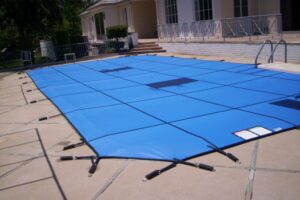Winterizing a saltwater pool helps prevent freezing temperatures from damaging the investment you’ve made in your property and also helps maintain a safer pool area to prevent accidental drownings. An unprotected pool poses a threat year-round to children, the elderly, other vulnerable humans, pets, and wildlife. In addition to the potential drowning risks, water mixed with low temperatures and biting wind can quickly lead to hypothermia and frostbite. From lowering the water level to installing your winter safety pool cover, we’ll walk you step-by-step through how to winterize a saltwater pool while making safety a priority.
Winter Hazards for Your Pool and the Ones You Love
As water freezes it expands building pressure if it’s trapped in a closed chamber. Out in the open, ice can appear to be solid, tempting children and animals to trust its glass-like surface. Once broken, razor-sharp shards can easily puncture, scratch, and cut, all while the frigid water underneath waits to steal body heat or trap you under heavy ice chunks. Winterizing a saltwater pool helps avoid the dangers presented by falling temperatures and ice formations.
- Plaster, Liners, and Tile – Floating ice can chip away at your pool’s tile and grout, tear liners, and damage plaster. Likewise, unmitigated exposure to dry, freezing air or sub-freezing temperatures in salt water can prematurely weather your pool’s interior.
- Pipes and Fixtures – Water trapped in pipes, pump housings, heaters, and other equipment can freeze and expand, increasing the pressure against the interior until it cracks and bursts.
- Drowning – Thousands of lives are lost to accidental drowning every year, and an unsecured pool area is dangerous even if it isn’t “swimming weather”.
- Hypothermia – Even if a potential drowning victim makes it out of the water, they’re still in danger from life-threatening hypothermia as their body temperature plummets quickly.
- Out of Sight, Out of Mind – Compounding the danger, too often, pool owners don’t think to check their pool when it’s not in use.
How to Winterize Your Saltwater Pool
Winterizing a saltwater pool is very similar to winterizing a chlorine pool. Don’t be fooled by misinformation that saltwater pools just require a higher salt concentration to protect them from freezing. While salt does effectively lower the temperature at which water freezes, your pool’s salinity won’t reach a high enough level to make a practical difference. What salt can do, however, is create a chemical reaction with other pool chemicals to increase the risk of staining. Learn how to winterize your saltwater pool properly to keep your pool and loved ones safer.
Step 1 – Plan Your Closing Date
You want your pool to be winterized before freezing temperatures–especially the first hard freeze of the season–hit. When temperatures are regularly dipping to below 65℉ as a high or below 50℉ at night, it’s time to winterize your pool to avoid damage from a surprise early freeze.
Step 2 – Balance Your Pool Chemistry
In the weeks leading up to your expected pol winterization date, make sure you’re keeping up with your regular pool maintenance. You want your pool to have a normal pH of 7.2-7.8, a hardness of 200-400 ppm, and an alkalinity of 80-120 ppm, the same general levels you’ve used for swimming.
Step 3 – Clean the Pool and Remove Equipment
Give your pool a thorough cleaning, scrubbing the floor and sides with a soft brush, vacuuming the bottom of the pool, and removing all debris and detritus. Next, remove any installed equipment, like slides and ladders. Once the pool is clean, add chlorine shock to kill any remaining algae, bacteria, or other biological contaminants. This will need time to circulate afterward, as high chlorine levels could harm your winter safety pool cover.
Step 4 – Add Your Winterization Chemicals
Once chlorine levels are back to a more normal 1-3 ppm, it’s time to add the chemicals designed to keep your pool safe from freezing temperatures. Check your manufacturer’s label for how to winterize a saltwater pool with the kit you’ve chosen. Check the chlorine levels one last time, then let your pump and filter run for at least 8 hours to ensure consistent dispersal throughout the full volume of your pool’s water.
Step 5 – Lower the Water Level
For most pools, you should drain your pool to a few inches below the skimmer. Some skimmer designs, including skimmers with a faceplate-type plug, may not require this step, but if in doubt, it’s better to be safe than sorry.
Step 6 – Clean and Drain all Equipment, Including Your Salt Generator
All pumps, filters, and heaters, including their housings, should be cleaned and drained following the manufacturer’s directions. Filter medium should be rinsed with a garden hose or back-washed to remove debris. Remove the salt cell from your generator and gently clean any buildup from the plates, taking care not to scratch or damage them. Finally, use an air compressor or wet/dry vacuum’s blower to push all water out of the pipes that lead to this equipment. Store the equipment, filter cartridges, screens, or salt cells you removed until spring.
Step 7 – Winterize Your Pool Hoses and Pipes
Just as you did with the equipment, clearing the water from your in-ground pipes is how to winterize your saltwater pool effectively. Use your compressor or vacuum to eliminate as much water as possible, removing the skimmer basket and eyeball fittings in your pool. This keeps water from pooling where it can form into expanding ice that leaves you with a huge repair bill.
Step 8 – Add Your Winter Swimming Pool Cover
A winter safety pool cover isn’t just designed to help your pool weather the cold but also to prevent unsupervised access to dangerously cold water. It uses strong anchors and a thicker mesh material to secure the pool and support the weight of a full-grown adult while also providing more insulation between the cooler outside air and the pool it’s covering.
Step 9 – Clean and Check Your Other Pool Safety Equipment
Now is the time to clean your removable mesh pool fence and check for any damage that may require repair or replacement parts. If you’ve been using a swimming pool safety net or standard swimming pool safety cover, they can be cleaned with a soft brush and light detergent, allowed to dry, and then neatly folded or rolled until it’s time to reopen the pool in spring. Don’t forget to check your pool safety alarms, including changing batteries or calling a pro for repairs if needed.
Get Your Pool Winter Ready
Make sure your saltwater pool winterizing includes protective barriers that help prevent accidental drownings. Your local independent installer is your community’s pool safety expert with the right experience and products to protect your property. Schedule a free visit, and they’ll take measurements, talk to you about your pool needs, and give you a written estimate for cost-effective peace of mind. Request your free quote from your local All-Safe Pool pro today.









